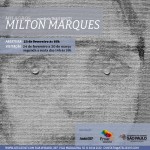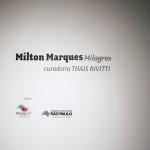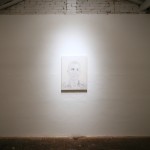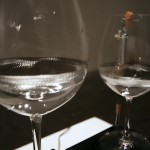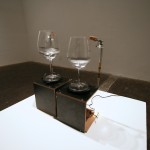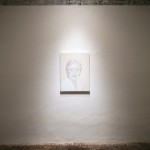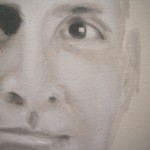Milagros | Milton Marques
Milton Marques
Milagros
Curadoria Thais Rivitti
Dia 23 de fevereiro, segunda-feira, o Ateliê397 com apoio da Secretaria de Cultura do Estado de São Paulo – via ProAC, inaugura a exposição “Milagros”, do artista Milton Marques, com curadoria de Thais Rivitti. A mostra é composta por dois trabalhos novos: uma dupla de retratos e um objeto plástico-sonoro, ambos sem título, de 2015.
Os retratos, de dois curadores brasileiros conhecidos, foram feitos a pedido do artista a partir de fotos achadas na internet. Milton encomenda as pinturas e, depois de recebê-las, adiciona a elas um mecanismo que as faz “chorar”. Gotas d’água brotam da tela, na altura dos olhos do retratados, e escorrem pelo quadro. Ao lado dos retratos, a exposição traz um trabalho no qual um mecanismo construído pelo artista faz um pedaço de cortiça roçar nas paredes de taças de cristal em rotação, gerando um ruído que se espalha pelo ambiente. O “choro” dos retratados encontra, assim, seu equivalente sonoro no barulho que vem do cristal.
Para a curadora, “o caráter postiço dessas presenças que se sobrepõem no espaço expositivo – o choro falso e o som estranho – colaboram para a criação de um ambiente onde mágica e truque, feitiço e embuste encontram-se em tensão”. O que estaria em jogo, para ela, é a própria função do curador no sistema da arte: “Nessa exposição, Milton explora a operação, algumas vezes atribuída ao curador, de transformar um objeto comum em obra de arte. Essa espécie de transubstanciação que, supostamente, o curador realizaria é, como todo milagre, um gesto cercado de contradições e ambiguidades: há algo sublime e algo duvidoso em sua natureza”.
Milton Marques é artista plástico nascido em Brasília em 1971. Já participou de inúmeras mostras, individuais e coletivas, no Brasil e no exterior dentre as quais destacam-se: “Situações Brasília”, Museu Nacional do Conjunto Cultural da República, Brasília, 2012; “Os Primeiros Dez Anos”, Instituto Tomie Ohtake, São Paulo, 2011; “Cinema, Sim – Narrativas e Projeções”, Itaú Cultural, 2008; “Nova Arte Nova”, Centro Cultural Banco do Brasil, São Paulo, 2009; “Contraditório – Panorama da Arte Brasileira”, Museu de Arte Moderna, 2007, “5a, Bienal do Mercosul”, Porto Alegre, Brasil, 2005 e “26a. Bienal de São Paulo”, São Paulo, Brasil, 2004.
Serviço:
Milagros, de Milton Marques
Abertura dia 23 a partir das 19H.
Visitação:
De 23 de fevereiro a 20 de março de 2015
De segunda a sexta-feira, das 14 às 19H
Programação gratuita.
Ateliê 397
Rua Wisard, 397
Vila Madalena – São Paulo
55 11 3034-2132
www.ateliê397.com
Milagros by Milton Marques
Ateliê397 with the support of the Secretaria de Cultura do Estado de São Paulo – through ProAC, opens on February 23, Monday, exhibition “Milagros” by artist Milton Marques, curated by Thais Rivitti. The show features two new works: a pair of portraits and an audio/plastic object, both of them untitled, from 2015.
The portraits of two popular Brazilian curators have been commissioned by the artist based on photos available on the Internet. After commissioning and receiving the paintings, Milton attaches them to a mechanism that makes them “cry”. Water drops flow from the screen at the level of the curators’ eyes and roll down the piece. A work is shown next to the portraits in which a mechanism built by the artist causes a piece of cork to rub rotating crystal glasses, producing a sound throughout the area. The “cry”
of the individuals portrayed is equivalent, in terms of sound, to the noise produced by the crystal.
According to the curator, “the faked nature of these presences that overlap in the exhibition area – the fake cry and the strange sound – helps create an atmosphere where magic and trick, spell and scam are found in tension”. In her view, the role of curators in the art system would be at stake: “In this
exhibition, Milton looks into the operation – sometimes ascribed to the curator – of transforming an ordinary object into a work of art. This kind of transformation that is supposedly carried out by a curator is like every miracle, an act surrounded by contradiction and ambiguity: there is something sublime and doubtful in its nature.”
Milton Marques is a visual artist who was born in Brasília in 1971. He has taken part in many solo and group exhibitions both in Brazil and abroad, including: “Situações Brasília” [Brasília Situations], at Museu Nacional do Conjunto Cultural da República, Brasília, 2012; “Os Primeiros Dez Anos” [The First Ten Years], at Instituto Tomie Ohtake, São Paulo, 2011; “Cinema, Sim – Narrativas e Projeções” [Cinema, Yes – Narratives and Projections], at Itaú Cultural, 2008; “Nova Arte Nova” [New Art New], at Centro Cultural Banco do Brasil, São Paulo, 2009; “Contraditório – Panorama da Arte Brasileira”
[Contradictory – An Overview of Brazilian Art], at Museu de Arte Moderna, 2007, “5th Mercosur Biennial”, Porto Alegre, Brazil, 2005, and “26th São Paulo Biennial”, São Paulo, Brazil, 2004.
Milagros by Milton Marques
Opens February 23 from 7 p.m.
Visits:
February 23 to March 20, 2015
Monday to Friday, 2 p.m. – 7 p.m.
Ateliê397
Rua Wisard, 397
Vila Madalena – São Paulo
55 11 3034 2132
www.ateliê397.com
MILAGROSpor Thais Rivitti
Na exposição “Milagros”, Milton Marques apresenta duas obras novas: um par de retratos de curadores brasileiros que, tendo acoplados um mecanismo de gotejamento, soltam água imitando um choro e um aparelho construído pelo artista no qual pedaços de cortiça encostam nas bordas de taças de cristal em constante rotação, propagando pelo ambiente um som ligeiramente diferente cada taça.Os retratos, de curadores conhecidos, foram encomendados pelo artista e tiveram como base fotografias disponibilizadas na internet ou em revistas de arte. As imagens se condensam na tela tal com vieram dos meios de comunicação e conservam algo de seu contexto original (uma expressão, uma pose). A série de retratos que Milton está fazendo compreende muitos outros retratados, além dos dois presentes. Mais do que a intenção de personificar esse ou aquele indivíduo, a discussão centra-se na própria figura (genérica) do curador que está atuando no presente, que aparece como resultado nas buscas do google ou o dá declarações sobre seu ofício à imprensa.
Depois de selecionar as imagens, Milton acopla a elas um mecanismo que faz com que elas soltem água pelos olhos, simulando o ato de chorar. Essa intervenção nas imagens, esse choro postiço inserido ali pelo artista, acaba por gerar uma série de relações provocantes. A ideia de milagre vem a mente uma vez que a obra evoca imediatamente as histórias populares que relatam imagens de santos que choram. Além disso, como o próprio nome da exposição sugere, milagros são também ex-votos, peças (fotos, desenhos, réplicas de partes do corpo) feitas em agradecimento a alguma graça alcançada.
“Milagros”, assim, refere-se muito diretamente ao universo mágico religioso do qual, no processo de modernização, a arte teria se separado. E não o faz sem certa ironia. Evidentemente há uma menção a certos poderes extraordinários que são atribuídos aos curadores em nosso sistema da arte. Mas a obra não para diante dessa denúncia, não se resolve em um esquema paródico. Se flerta com o cômico, também recoloca as dificuldades que hoje cercam a atuação desse profissional cuja tarefa é a de separar o joio do trigo na produção de arte de seu tempo. Os critérios para se afirmar a qualidade a um objeto de arte talvez nunca tenham sido tão difíceis de enunciar quanto são hoje. Por mais que curadores esforcem-se em tornar claras suas escolhas, posições e olhares, há sempre algo, em uma leitura de obra, em uma aposta nesse ao naquele artista, que não pode ser sintetizado por um discurso rigorosamente objetivo. Talvez as lágrimas venham dessa condição – mais semelhante a do profeta do que ao santo – de muito solitariamente enxergar algo ali, onde normalmente não se vê nada.
A evocação do milagre está presente também na obra sonora, que acaba por funcionar como um coro, uma tradução sonora dos vários choros no espaço. Preenchidas com vinho, as taças, que são componentes essenciais da peça recém realizada, remetem tanto ao episódio bíblico das Bodas de Caná, onde Jesus transforma água em vinho, como ao próprio ato litúrgico da eucaristia, no qual o vinho transubstancia-se em sangue de Cristo. Nessa exposição, Milton explora a operação, em parte atribuída ao curador, de transformar um objeto comum em obra de arte. Essa espécie de transubstanciação que, supostamente, o curador realizaria é, como todo milagre, um gesto cercado de contradições e ambiguidades: há algo sublime e algo duvidoso em sua natureza.
MILAGROSby Thais RIvitti
Exhibition “Milagros” by Milton Marques shows two new works: a couple of portraits of Brazilian curators with a built-in drip mechanism shedding water through the eyes, and an apparatus built by the artist in which pieces of cork slip by the edges of constantly rotating crystal glasses, with each glass producing a slightly different sound.The portraits have been commissioned by the artist: they are images of well-known curators, based on photos available on the Internet or in art magazines. The images appear on the screen just like they originally appeared in the media, and retain something from their original contexts (an expression, a pose). The series of portraits being produced by Milton includes many other individuals besides the two shown in the exhibition. Rather than personifying specific individuals, the discussion focuses on the (generic) figure of the curator who is acting at the moment, who is listed in Google search results or makes statements about his or her occupation to the press.
After selecting the images, Milton attaches them to a mechanism that makes them drip water through the eyes, simulating the act of crying. The intervention in the images and the crying faked by the artist produce a series of provoking analogies. The idea of a miracle comes to mind as the work immediately evokes popular stories about images of weeping saints. In addition, as the name of the exhibition suggests, milagros are also former vows, pieces (photos, drawings, replica of body parts) made in order to thank for blessings received.
Thus, the work somehow brings back the enchantment of the world to the discussion of contemporary art. This is not without irony, though. There is obviously a reference to certain extraordinary powers that are assigned to curators in our art system. But the work goes further and is not resolved in a parodic scheme. If it flirts with comedy it also approaches the difficulties currently experienced by this professional whose job is to separate the wheat from the chaff in the production of art of his or her time.
The criteria for claiming the quality of an artwork may never have been so hard to formulate as they are today. Although curators strive to make their choices, positions and views clear, there is always something that cannot be synthesized by a strictly objective discourse in reading an artwork or betting on a particular artist. Perhaps the tears come from this capacity – more like the prophet’s than the saint’s – to see something there from a very lonely position, where one sees nothing.
The evocation of the miracle is also present in the audio work, which ultimately functions as a choir, an audio translation of several cries in the space. Filled with wine, the glasses are key components of the play that has just been held, referring both to the biblical account of the Marriage at Cana, where Jesus turns water into wine, and the very liturgical act of the Eucharist, in which wine becomes the blood of Christ. In this exhibition, Milton looks into the operation – partially ascribed to the curator – of transforming an ordinary object in a work of art. This kind of transformation that is supposedly carried out by a curator is like every miracle, an act surrounded by contradiction and ambiguity: there is something sublime and doubtful in its nature.

